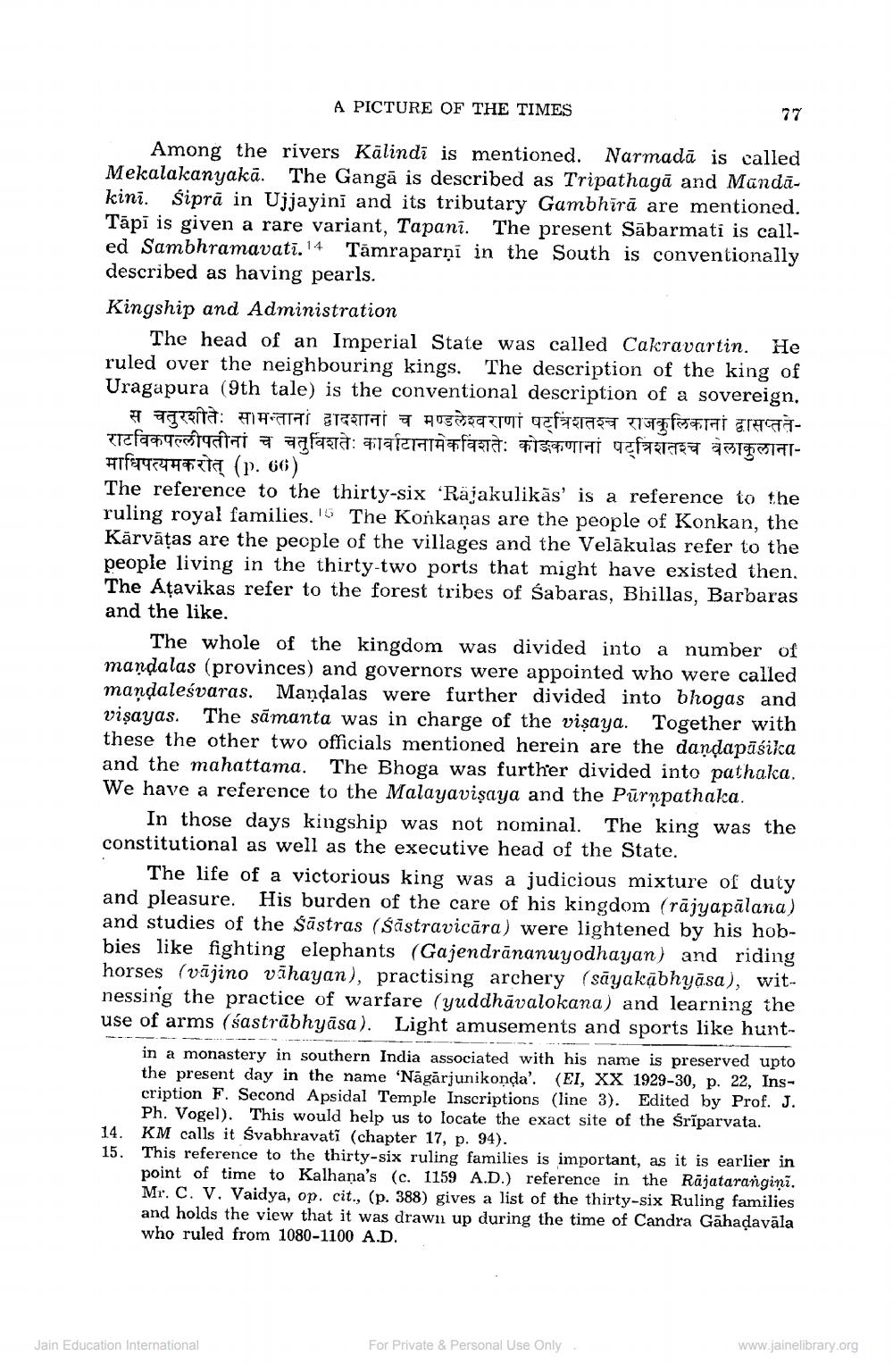________________
A PICTURE OF THE TIMES
Among the rivers Kālindi is mentioned. Narmadā is called Mekalakanyakā. The Gangā is described as Tripathagā and Mandākini. Siprā in Ujjayini and its tributary Gambhīrā are mentioned. Tāpi is given a rare variant, Tapani. The present Sabarmati is called Sambhramavati.14 Tāmraparņi in the South is conventionally described as having pearls. Kingship and Administration
The head of an Imperial State was called Cakravartin. He ruled over the neighbouring kings. The description of the king of Uragapura (9th tale) is the conventional description of a sovereign,
स चतुरशीतेः सामन्तानां द्वादशानां च मण्डलेश्वराणां पत्रिंशतश्च राजकूलिकानां द्वासप्ततेराटविकपल्लीपतीनां च चतुर्विशतेः कार्वाटानामेकविंशतेः कोकणानां पत्रिशतश्च वेलाकुलानाFfTchata (P. 60) The reference to the thirty-six 'Rajakulikās' is a reference to the ruling royal families. 16 The Konkaņas are the people of Konkan, the Kārvātas are the people of the villages and the Velākulas refer to the people living in the thirty-two ports that might have existed then. The Ațavikas refer to the forest tribes of Sabaras, Bhillas, Barbaras and the like.
The whole of the kingdom was divided into a number of mandalas (provinces) and governors were appointed who were called mandalesvaras. Mandalas were further divided into blogas and visayas. The samanta was in charge of the visaya. Together with these the other two officials mentioned herein are the dandapāśika and the mahattama. The Bhoga was further divided into pathaka, We have a reference to the Malayavişaya and the Pūrnpathaka.
In those days kingship was not nominal. The king was the constitutional as well as the executive head of the State.
The life of a victorious king was a judicious mixture of duty and pleasure. His burden of the care of his kingdom (rajyapālana) and studies of the Sāstras (Šāstravicāra) were lightened by his hobbies like fighting elephants (Gajendrānanuyodhayan) and riding horses (vājino vāhayan), practising archery (sāyakābhyāsa), witnessing the practice of warfare (yuddhāvalokana) and learning the use of arms (sastrăbhyāsa). Light amusements and sports like hunt
in a monastery in southern India associated with his name is preserved upto the present day in the name 'Nagarjunikonda'. (EI, XX 1929-30, p. 22, Inscription F. Second Apsidal Temple Inscriptions (line 3). Edited by Prof. J.
Ph. Vogel). This would help us to locate the exact site of the Śrīparvata. 14. KM calls it Švabhravati (chapter 17, p. 94). 15. This reference to the thirty-six ruling families is important, as it is earlier in
point of time to Kalhana's (c. 1159 A.D.) reference in the Rajatarangini. Mr. C. V. Vaidya, op. cit., (p. 388) gives a list of the thirty-six Ruling families and holds the view that it was drawn up during the time of Candra Gāhadavāla who ruled from 1080-1100 A.D.
For Private & Personal Use Only
www.jainelibrary.org
Jain Education International




